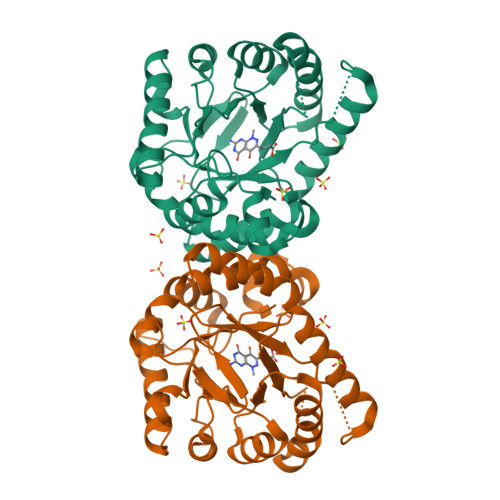Structure-Based Design of Novel Pyrimido[4,5-c]pyridazine Derivatives as Dihydropteroate Synthase Inhibitors with Increased Affinity.
Zhao, Y., Hammoudeh, D., Yun, M.K., Qi, J., White, S.W., Lee, R.E.(2012) ChemMedChem 7: 861-870
- PubMed: 22416048
- DOI: https://doi.org/10.1002/cmdc.201200049
- Primary Citation of Related Structures:
4D8A, 4D8Z, 4D9P, 4DAF, 4DAI, 4DB7 - PubMed Abstract:
Dihydropteroate synthase (DHPS) is the validated drug target for sulfonamide antimicrobial therapy. However, due to widespread drug resistance and poor tolerance, the use of sulfonamide antibiotics is now limited. The pterin binding pocket in DHPS is highly conserved and is distinct from the sulfonamide binding site. It therefore represents an attractive alternative target for the design of novel antibacterial agents. We previously carried out the structural characterization of a known pyridazine inhibitor in the Bacillus anthracis DHPS pterin site and identified a number of unfavorable interactions that appear to compromise binding. With this structural information, a series of 4,5-dioxo-1,4,5,6-tetrahydropyrimido[4,5-c]pyridazines were designed to improve binding affinity. Most importantly, the N-methyl ring substitution was removed to improve binding within the pterin pocket, and the length of the side chain carboxylic acid was optimized to fully engage the pyrophosphate binding site. These inhibitors were synthesized and evaluated by an enzyme activity assay, X-ray crystallography, isothermal calorimetry, and surface plasmon resonance to obtain a comprehensive understanding of the binding interactions from structural, kinetic, and thermodynamic perspectives. This study clearly demonstrates that compounds lacking the N-methyl substitution exhibit increased inhibition of DHPS, but the beneficial effects of optimizing the side chain length are less apparent.
Organizational Affiliation:
Department of Chemical Biology and Therapeutics, St. Jude Children's Research Hospital, Memphis, TN 38105, USA.




















